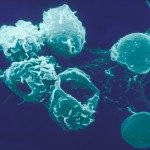Lien vers Pubmed [PMID] – 27424216
Biomaterials 2016 Oct;104:52-64
A main challenge in cardiac tissue engineering is the limited data on microenvironmental cues that sustain survival, proliferation and functional proficiency of cardiac cells. The aim of our study was to evaluate the potential of fetal (E18) and adult myocardial extracellular matrix (ECM) to support cardiac cells. Acellular three-dimensional (3D) bioscaffolds were obtained by parallel decellularization of fetal- and adult-heart explants thereby ensuring reliable comparison. Acellular scaffolds retained main constituents of the cardiac ECM including distinctive biochemical and structural meshwork features of the native equivalents. In vitro, fetal and adult ECM-matrices supported 3D culture of heart-derived Sca-1(+) progenitors and of neonatal cardiomyocytes, which migrated toward the center of the scaffold and displayed elongated morphology and excellent viability. At the culture end-point, more Sca-1(+) cells and cardiomyocytes were found adhered and inside fetal bioscaffolds, compared to the adult. Higher repopulation yields of Sca-1(+) cells on fetal ECM relied on β1-integrin independent mitogenic signals. Sca-1(+) cells on fetal bioscaffolds showed a gene expression profile that anticipates the synthesis of a permissive microenvironment for cardiomyogenesis. Our findings demonstrate the superior potential of the 3D fetal microenvironment to support and instruct cardiac cells. This knowledge should be integrated in the design of next-generation biomimetic materials for heart repair.

